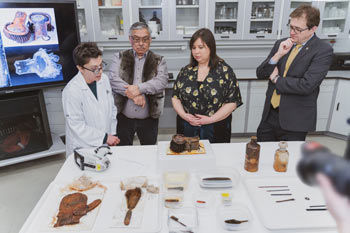New discoveries from HMS Erebus
Wrecks of HMS Erebus and HMS Terror National Historic Site
Transcript
Parks Canada Logo
In 2019, Parks Canada’s Underwater Archaeology Team returned to Wilmot and Crampton Bay in Nunavut, to continue the research on the wreck of HMS Erebus -- one of two lost vessels of the 1845 Sir John Franklin Expedition. As one of the largest, most complex underwater archaeological undertakings in Canadian history, Parks Canada and Inuit are working in partnership to explore the wrecks of HMS Erebus and HMS Terror.
The Government of Canada’s on-going investigation of the wrecks is a collaboration with the Inuit Heritage Trust and based on the advice of the Franklin Interim Advisory Committee. The goal is to document and protect the Wrecks of HMS Erebus and HMS Terror National Historic Site to help unravel the mysteries of the Franklin Expedition.
Prior to archaeological work, the Parks Canada research vessel David Thompson rendezvoused with the Canadian Coast Guard icebreaker Sir Wilfrid Laurier. This allowed for the David Thompson to be refuelled after its 5,000 nautical mile voyage to the Arctic.
Survey equipment and a pair of 3-tonne mooring anchors supplied by the Canadian Coast Guard were transferred to the diving support barge “Qiniqtiryuaq” — which means “searching for some thing or person which was lost.” With the barge set-up and securely moored over the wreck of HMS Erebus, the diving operation began in earnest.
During a three-week period, Parks Canada’s Underwater Archaeology Team completed a total of 93 dives, spending approximately 110 hours underwater.
Marc-André Bernier: “I would like to show you a bit of what we’ve done… and how we’re proceeding with excavation… and what we’ve found.”
This year’s excavation efforts focused on two areas along the port side of the lower deck - - an officer’s cabin for the third Lieutenant, and the captain’s steward’s pantry. Within these two adjacent areas, enclosed drawers in fitted cabinets and the remains of cupboards were found, in which a trove of stored artifacts were revealed. All newly discovered artifacts from HMS Erebus and HMS Terror are jointly-owned by the Government of Canada and Inuit.
Parks Canada’s Underwater Archaeology Team uses water induction dredges, trowels, and sometimes light hand-fanning to carefully remove sediments from around buried artifacts, exposing them for mapping, photography, and recovery.
Artefacts from the captain’s steward’s pantry included an abundance of ceramic tableware and beverage containers among other, more personal items such as clothing, a toothbrush with intact bristles and remnants of an accordion.
The precise position and depth of each artifact is recorded before it is gently removed, packaged and brought to the surface for the first time in over 170 years.
Delicate organic materials such as sealing wax and textiles are well preserved in the cold dark Arctic waters, which are covered by sea ice for much of the year.
At the end of the field season, the barge is untethered from its moorings and towed back to the community of Gjoa Haven where it will spend a long winter until next year’s operations.
Over 350 artifacts were recovered during the 2019 field season, including this stunning epaulette from a Lieutenant’s dress uniform. These artifacts are currently undergoing preliminary analysis - - a process that includes identifying the physical characteristics of each object, scaled illustrations, x-rays, and studio photography. Once the analysis is complete, the artifacts will go to the conservation lab for treatment and stabilization.
The systematic excavation of HMS Erebus has only just begun in collaboration with the Inuit Heritage Trust as co-owners of the artifacts. Parks Canada’s Underwater Archaeology Team is excited to return to the Wrecks of HMS Erebus and HMS Terror National Historic Site to expand the exploration these shipwrecks to new areas. There is much promise of yielding further insights into the shipboard lives of the crew, while hopefully uncovering more clues as to what happened in the final days of the Franklin Expedition.
Parks Canada recognizes the invaluable role of Inuit, the Government of Nunavut, and all partners, in the discoveries of the Franklin wrecks. Most importantly, the discoveries would not have been possible without the support, guidance, advice and knowledge shared so generously by Inuit.
The Wrecks of HMS Erebus and HMS Terror National Historic Site is protected by a restricted area and activity order on the recommendation of the Franklin Interim Advisory Committee. Entering the site without a permit is an offence under the Canada National Parks Act, and is punishable by a fine of up to $500,000. The wreck sites are actively and remotely monitored by the Government of Canada, in partnership with Inuit Guardians. These restrictions do not affect the right of access by Nunavut Inuit for harvesting as provided in the Nunavut Agreement.
- Date modified :
